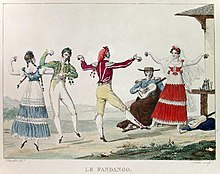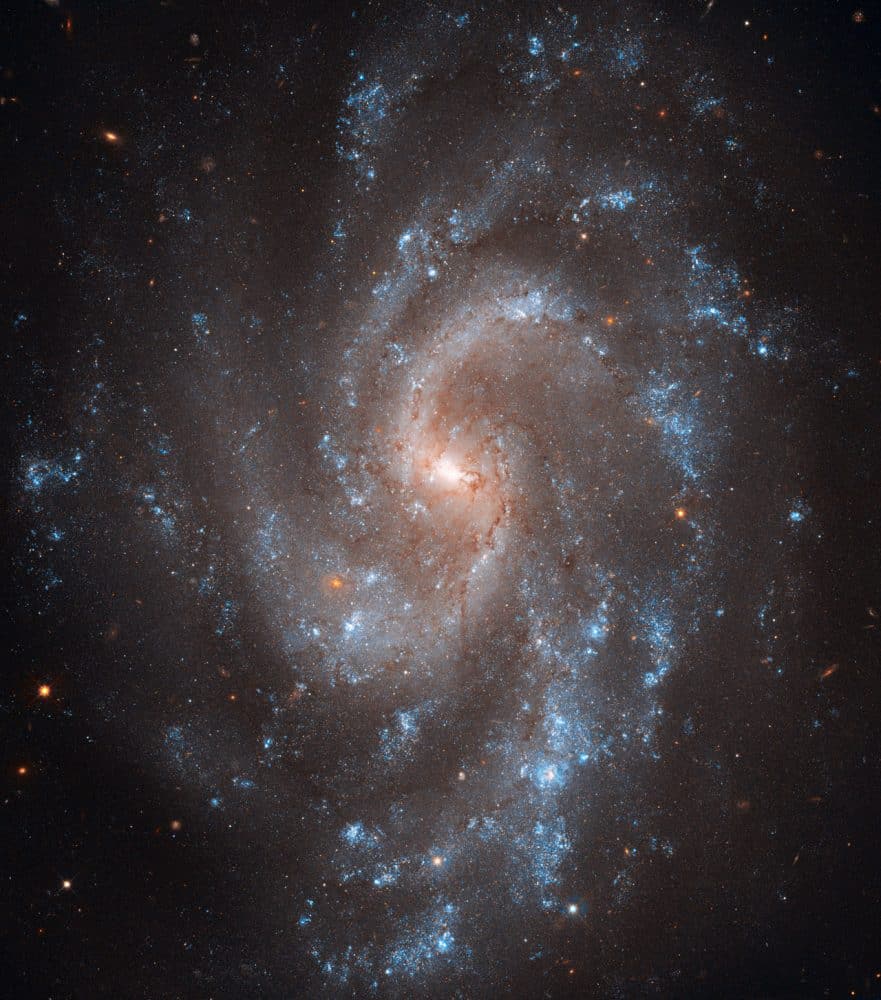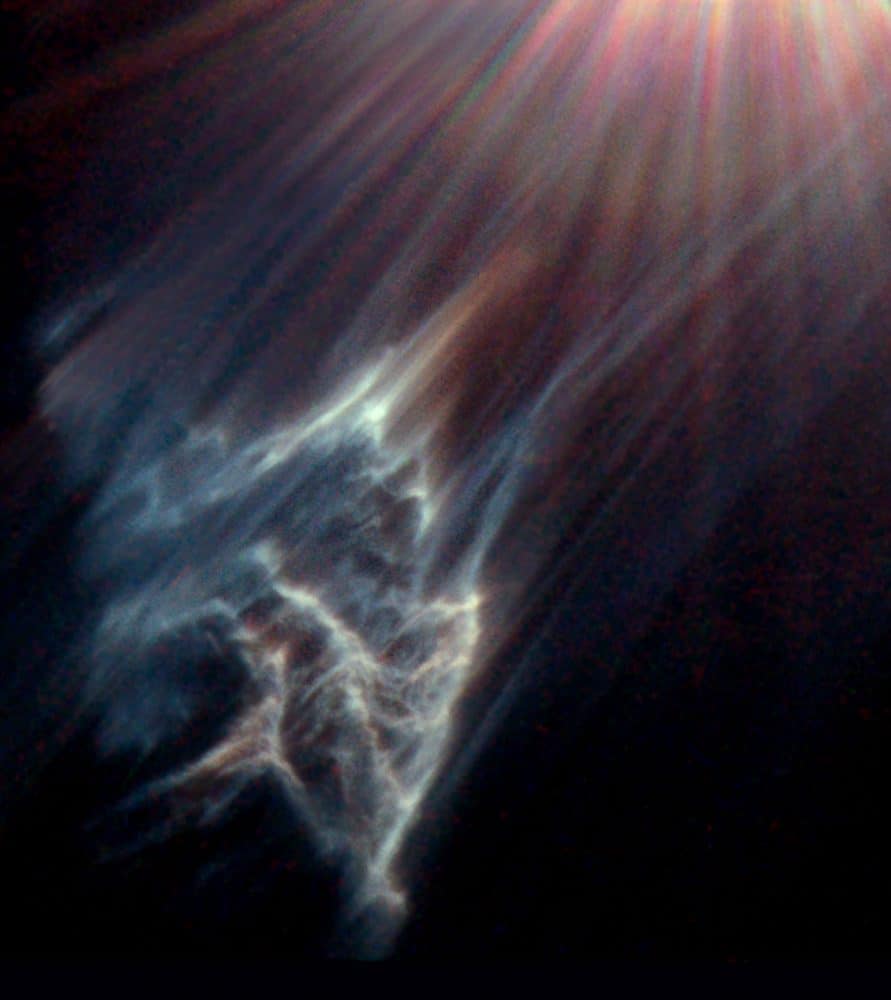Blog
NGC 7814 (also known as UGC 8 or Caldwell 43) is a spiral galaxy about 40 million light-years away in the constellation Pegasus. The galaxy is seen edge-on from Earth. It is sometimes referred to as “the little sombrero”, a miniature version of Messier 104. The star field behind NGC 7814 is known for its density of faint, remote galaxies as can be seen in the image here – in the same vein as the Hubble Deep Field.
more...
Lee Mack Ritenour (born January 11, 1952) is an American guitarist who has been active since the late 1960s, playing numerous styles of jazz. He has been described as a “flawless” “musical chameleon” by AllMusic. Ritenour has won one Grammy Award with a sum of sixteen nominations.
Ritenour was born on January 11, 1952 in Los Angeles, California. At the age of eight he started playing guitar and four years later decided on a career in music. When he was 16 he played on his first recording session with the Mamas & the Papas. He developed a love for jazz and was influenced by guitarist Wes Montgomery. At the age of 17 he worked with Lena Horne and Tony Bennett. He studied classical guitar at the University of Southern California.
Ritenour’s solo career began with the album First Course (1976), a good example of the jazz-funk sound of the 1970s, followed by Captain Fingers, The Captain’s Journey (1978), and Feel the Night (1979).
In 1979, he “was brought in to beef up one of Pink Floyd’s The Wall ‘ heaviest rock numbers, “Run Like Hell“.[4] He played “uncredited rhythm guitar” on “One of My Turns“. As the 1980s began, Ritenour began to add stronger elements of pop to his music, beginning with Rit (1981). “Is It You” with vocals by Eric Tagg reached No. 15 on the Billboard pop chart and No. 27 on the Soul chart.[7] The track peaked at number fifteen on Hot Adult Contemporary chart. He continued with the pop-oriented music for Rit/2 (1982) and Banded Together (1984), while releasing a Direct-Disk instrumental album in 1983 called On the Line. He also provided rhythm guitar on Tom Browne‘s album Funkin’ for Jamaica. He recorded Harlequin (1985) with Dave Grusin and vocals by Ivan Lins. His next album, Earth Run, was nominated for a Grammy Award for Best Jazz Fusion Performance. The album’s title track was also Grammy nominated in the category of Best Instrumental Composition.[3][9] Portrait (GRP, 1987) included guest performances by The Yellowjackets, Djavan, and Kenny G.
more...
Calvin “Cal” Massey (January 11, 1928 – October 25, 1972) was an American jazz trumpeter and composer.
In the late 1950s he led an ensemble with Jimmy Garrison, McCoy Tyner, and Tootie Heath; John Coltrane and Donald Byrd occasionally played with them. In the 1950s he gradually receded from active performance and concentrated on composition; his works were recorded by Coltrane, Tyner, Freddie Hubbard, Jackie McLean, Lee Morgan, Philly Joe Jones, Horace Tapscott and Archie Shepp. Massey played and toured with Shepp from 1969 until 1972. He also performed in The Romas Orchestra with Romulus Franceschini.
Massey died from a heart attack at the age of 44 in New York City, New York. His son, Zane Massey (born 1957), is also a jazz musician.
more...James Isaac Moore (January 11, 1924 – January 31, 1970), better known by his stage name Slim Harpo, was an American blues musician, a leading exponent of the swamp bluesstyle, and “one of the most commercially successful blues artists of his day”. His most successful and influential recordings included “I’m a King Bee” (1957), “Rainin’ In My Heart” (1961), and “Baby Scratch My Back” (1966) which reached no. 1 on the R&B chart and no.16 on the US pop chart. A master of the blues harmonica, his stage name was derived from the popular nickname for that instrument, the “harp”.
Moore was born in Lobdell, Louisiana, the eldest child in his family. After his parents died he worked as a longshoreman and construction worker in New Orleans in the late 1930s and early 1940s. Influenced in style by Jimmy Reed, he began performing in Baton Rouge bars under the name Harmonica Slim, and also accompanied his brother-in-law Lightnin’ Slim in live performances.
He started his own recording career in March 1957, working with the A&R man and record producer J. D. “Jay” Miller in Crowley, Louisiana. At his wife’s suggestion, he took the name Slim Harpo in order to differentiate himself from another performer called Harmonica Slim. His first solo release, for Excello Records, based in Nashville, Tennessee, was “I’m a King Bee“, backed with “I Got Love If You Want It” in 1957. The other musicians on the recording were Gabriel “Guitar Gable” Perrodin (guitar), John “Fats” Perrodin (bass), and Clarence “Jockey” Etienne (drums). Harpo played guitar in his live shows, but he usually used other guitarists when recording. The record was a regional hit but failed to make the national charts.
more...World Music on Flamenco Fridays featuring Fandango.
Fandango is a lively couples dance from Spain, usually in triple metre, traditionally accompanied by guitars, castanets, or hand-clapping (“palmas” in Spanish). Fandango can both be sung and danced. Sung fandango is usually bipartite: it has an instrumental introduction followed by “variaciones”. Sung fandango usually follows the structure of “cante” that consist of four or five octosyllabic verses (coplas) or musical phrases (tercios). Occasionally, the first copla is repeated.
Eighteenth century Castilianfandango dancers (by Pierre Chasselat) (1753–1814)
Fandango rhythm.
The meter of fandango is similar to that of the bolero and seguidilla. It was originally notated in 6/8 time, but later in 3/8 or 3/4.
more...
https://www.youtube.com/watch?v=SDJSXHkd6z8
more...The plane of our Milky Way Galaxy runs through this complex and beautiful skyscape. Seen toward colorful stars near the northwestern edge of the constellation Vela (the Sails), the 16 degree wide, 200 frame mosaic is centered on the glowing filaments of the Vela Supernova Remnant, the expanding debris cloud from the death explosion of a massive star. Light from the supernova explosion that created the Vela remnant reached Earth about 11,000 years ago. In addition to the shocked filaments of glowing gas, the cosmic catastrophe also left behind an incredibly dense, rotating stellar core, the Vela Pulsar. Some 800 light-years distant, the Vela remnant is likely embedded in a larger and older supernova remnant, the Gum Nebula. Objects identified in this broad mosaic include emission and reflection nebulae, star clusters, and the remarkable Pencil Nebula.
more...Sir Roderick David Stewart, CBE (born 10 January 1945) is a British rock singer and songwriter. Born and raised in London, he is of Scottish and English ancestry. Stewart is one of the best-selling music artists of all time, having sold over 100 million records worldwide. He has had six consecutive number one albums in the UK and his tally of 62 UK hit singles includes 31 that reached the top ten, six of which gained the #1 position.Stewart has had 16 top ten singles in the US, with four reaching #1 on the Billboard Hot 100. He was knighted in the 2016 Birthday Honours for services to music and charity.
With his distinctive raspy singing voice, Stewart came to prominence in the late 1960s and the early 1970s with The Jeff Beck Group, and then with Faces, though his music career had begun in 1962 when he took up busking with a harmonica. In October 1963, he joined The Dimensions as a harmonica player and part-time vocalist. In 1964, Stewart joined Long John Baldry and the All Stars, and in August, Stewart signed a solo contract, releasing his first single, “Good Morning Little Schoolgirl“, in October. He maintained a solo career alongside a group career, releasing his debut solo album, An Old Raincoat Won’t Ever Let You Down in 1969. Stewart’s early albums were a fusion of rock, folk music, soul music, and R&B.
From the late 1970s through the 1990s, Stewart’s music often took on a new wave or soft rock/middle-of-the-road quality, and in the early 2000s, he released a series of successful albums interpreting the Great American Songbook. In 1994, Stewart staged the largest free rock concert in history when he performed in front of 3.5 million people in Rio de Janeiro. In 2008, Billboard magazine ranked him the 17th most successful artist on the “Billboard Hot 100 All-Time Top Artists”. A Grammy and Brit Award recipient, he was voted at #33 in Q Magazine‘s list of the Top 100 Greatest Singers of all time, and #59 on Rolling Stone 100 Greatest Singers of all time. As a solo artist, Stewart was inducted into the US Rock and Roll Hall of Fame in 1994, the UK Music Hall of Fame in 2006, and was inducted a second time into the US Rock and Roll Hall of Fame in 2012 as a member of Faces.
more...Mike Stern (born January 10, 1953) is a six-time Grammy-nominated American jazz guitarist. After playing with Blood, Sweat & Tears, he worked with drummer Billy Cobham, then with trumpeter Miles Davis from 1981 to 1983 and again in 1985. Following that, he began a solo career, releasing more than a dozen albums.
Stern was named Best Jazz Guitarist of 1993 by Guitar Player magazine. At the Festival International de Jazz de Montréal in June 2007, he was given the Miles Davis Award, which was created to recognize internationally acclaimed jazz artists whose work has contributed significantly to the renewal of the genre. In 2009 he was listed on Down Beat‘s list of 75 best jazz guitarist of all time. He was presented with Guitar Player magazine’s Certified Legend Award on January 21, 2012.
Mike Stern was born Michael Sedgwick in Boston, Massachusetts, the son of Helen (Burroughs) and Henry Dwight Sedgwick V.[1] His sister Holly is the mother of actor Philip Nozuka and singers George Nozuka, Justin Nozuka, and Henry Nozuka. Stern is married to guitarist and vocalist Leni Stern.
more...Maxwell Lemuel Roach (January 10, 1924 – August 16, 2007) was an American jazz drummer and composer. A pioneer of bebop, he worked in many other styles of music, and is generally considered alongside the most important drummers in history. He worked with many famous jazz musicians, including Coleman Hawkins, Dizzy Gillespie, Charlie Parker, Miles Davis, Duke Ellington, Thelonious Monk, Abbey Lincoln, Dinah Washington, Charles Mingus, Billy Eckstine, Stan Getz, Sonny Rollins, Eric Dolphy, and Booker Little. He was inducted into the DownBeat Hall of Fame in 1980 and the Modern Drummer Hall of Fame in 1992.
Roach also led his own groups, most notably a pioneering quintet co-led with trumpeter Clifford Brown and the percussion ensemble M’Boom. He made numerous musical statements relating to the civil rights movement.
Max Roach was born to Alphonse and Cressie Roach in the Township of Newland, Pasquotank County, North Carolina, which borders the southern edge of the Great Dismal Swamp. Many confuse the Township of Newland with Newland Town in Avery County, North Carolina. Although his birth certificate lists his date of birth as January 10, 1924, Roach has been quoted by Phil Schaap as having stated that his family believed he was actually born on January 8, 1925.
Roach’s family moved to the Bedford-Stuyvesant neighborhood of Brooklyn, New York when he was 4 years old. He grew up in a musical home, his mother being a gospel singer. He started to play bugle in parade orchestras at a young age. At the age of 10, he was already playing drums in some gospel bands.
In 1942, as an 18-year-old recently graduated from Boys High School, he was called to fill in for Sonny Greer with the Duke Ellington Orchestra when they were performing at the Paramount Theater in Manhattan. He starting going to the jazz clubs on 52nd Street and at 78th Street & Broadway for Georgie Jay’s Taproom, where he played with schoolmate Cecil Payne.[5] His first professional recording took place in December 1943, supporting Coleman Hawkins.
He was one of the first drummers, along with Kenny Clarke, to play in the bebop style. Roach performed in bands led by Dizzy Gillespie, Charlie Parker, Thelonious Monk, Coleman Hawkins, Bud Powell, and Miles Davis. He played on many of Parker’s most important records, including the Savoy Records November 1945 session, which marked a turning point in recorded jazz. His early brush work with Powell’s trio, especially at fast tempos, has been highly praised.
more...
Juluka was a trailblazing band based in Johannesburg, South Africa, led by Johnny Clegg and Sipho Mchunu.
more...NGC 5584 was first spotted as a faint glow in the constellation of Virgo by the great visual observer E. E. Barnard, back in 1881, using just a 12.5-cm telescope. But, by bringing the power of Hubble to bear, the galaxy can be resolved into thousands of separate stars. Some of these stars vary in brightness and are classified as Cepheids. These are brilliant pulsating stars with a remarkable property — once the time it takes a Cepheid to brighten and fade is known, then it is possible to find how bright it actually is. When this information is combined with a measurement of how bright the star appears it is easy to work out how far away the star actually lies. This method is the most accurate and effective way to measure the distances to most nearby galaxies.
This trick has now been used as part of a major new study of the expansion rate of the Universe, led by Adam Riess at the Space Telescope Science Institute in Baltimore. By studying many Cepheids in several galaxies the team has been able to refine our knowledge of this expansion rate, expressed as a number known as Hubble’s constant, to an accuracy of 3.3 percent.
In addition to many Cepheids NGC 5584 was also recently the site of a type Ia supernova. These dramatic explosions of white dwarf stars are used as reference beacons for mapping the expansion, and acceleration, of the more remote Universe so this galaxy is a very valuable link between the two distance scales.
more...Joan Chandos Baez (/baɪz/; born January 9, 1941 Staten Island, NY) is an American singer, songwriter, musician, and activist[3] whose contemporary folk music often includes songs of protest or social justice. Baez has performed publicly for over 60 years, releasing over 30 albums. Fluent in Spanish and English, she has also recorded songs in at least six other languages. Although regarded as a folk singer, her music has diversified since the counterculture era of the 1960s, and encompasses genres such as folk rock, pop, country and gospel music.
Although a songwriter herself, Baez generally interprets other composers’ work,having recorded songs by Bob Dylan, the Allman Brothers Band, the Beatles, Jackson Browne, Leonard Cohen, Woody Guthrie, Violeta Parra, The Rolling Stones, Pete Seeger, Paul Simon, Stevie Wonder and many others. On her past several albums, she has found success interpreting songs of more recent songwriters, including Ryan Adams, Josh Ritter, Steve Earle, Natalie Merchant and Joe Henry.
She began her recording career in 1960 and achieved immediate success. Her first three albums, Joan Baez, Joan Baez, Vol. 2, and Joan Baez in Concert all achieved gold record status.
Songs of acclaim include “Diamonds & Rust” and covers of Phil Ochs‘s “There but for Fortune” and The Band‘s “The Night They Drove Old Dixie Down“. She is also known for “Farewell, Angelina“, “Love Is Just a Four-Letter Word“, “Forever Young“, “Here’s to You“, “Joe Hill“, “Sweet Sir Galahad” and “We Shall Overcome“. She was one of the first major artists to record the songs of Bob Dylan in the early 1960s; Baez was already an internationally celebrated artist and did much to popularize his early songwriting efforts.Baez also performed fourteen songs at the 1969 Woodstock Festival and has displayed a lifelong commitment to political and social activism in the fields of nonviolence, civil rights, human rights and the environment.
more...John Paul “Bucky” Pizzarelli (born January 9, 1926) is an American jazz guitarist. He is the father of jazz guitarist John Pizzarelli and double bassist Martin Pizzarelli. He worked for NBC as a staffman for Dick Cavett (1971) and ABC with Bobby Rosengarden in (1952). The list of musicians he has collaborated with includes Benny Goodman, Les Paul, and Stéphane Grappelli. Pizzarelli cites as influences Django Reinhardt, Freddie Green, and George Van Eps.
Pizzarelli was born January 9, 1926 in Paterson, New Jersey. He learned to play guitar and banjo at a young age. His uncles, Pete and Bobby Domenick, were professional musicians, and sometimes the extended family would gather at one of their homes with their guitars for jam sessions. Pizzarelli cites as an inspiration Joe Mooney, a blind accordion player who led a quartet that included Pizzarelli’s uncle, Bobby Domenick. During high school, Pizzarelli was guitarist for a small band that performed classical music.
Pizzarelli began his professional career at 17 when he joined the Vaughn Monroe dance band in 1944.
In 1952 Pizzarelli became a staff musician for NBC, playing with Skitch Henderson. In 1964, he became a member of The Tonight Show Band on The Tonight Show Starring Johnny Carson. During his time spent performing for the Tonight Show, he accompanied guest bands and musicians playing through a variety of musical genres, including playing with Tiny Tim (after tuning the performer’s ukulele) on the day that Tiny Tim married Miss Vicki on Carson’s show. His solo on “Lipstick on Your Collar” by Connie Francis has been called as “the greatest pop rock ‘n’ roll guitar solo of all time.
more...Kenneth Clarke Spearman (January 9, 1914 – January 26, 1985), usually known as Kenny Clarke and nicknamed Klook, was an American jazz drummer and bandleader. A major innovator of the bebop style of drumming, he pioneered the use of the Ride cymbal to keep time rather than the hi-hat, along with the use of the bass drum for irregular accents (“dropping bombs“).
Born in Pittsburgh, Pennsylvania, he was orphaned at the age of about five and began playing the drums when he was about eight or nine on the urging of a teacher at his orphanage. Turning professional in 1931 at the age of seventeen, he moved to New York City in 1935, establishing his drumming style and reputation. As the house drummer at Minton’s Playhouse in the early 1940s, he participated in the after-hours jams that led to the birth of bebop. After military service in the US and Europe between 1943 and 1946,he returned to New York, but between 1948 and 1951 he was mostly based in Paris. He stayed in New York between 1951 and 1956, performing with the Modern Jazz Quartet and playing on early Miles Davisrecordings during this time. He then moved permanently to Paris, where he performed and recorded with European and visiting American musicians and co-led the Kenny Clarke/Francy Boland Big Band between 1961 and 1972. He continued to perform and record until the month before he died of a heart attack in January 1985.
Clarke was born in Pittsburgh, Pennsylvania on January 9, 1914[note 1] as the youngest of two sons, to Martha Grace Scott, a pianist from Pittsburgh, and Charles Spearman, a trombonist from Waycross, Georgia. The family home was on Wylie Avenue in the Lower Hill District of Pittsburgh. Clarke’s father left the household to start a new family in Yakima, Washington, and his mother, who began a relationship with a Baptist preacher shortly afterwards, died suddenly in her late twenties when Clarke was about five, leaving him an orphan. He and his brother were placed in the Coleman Industrial Home for Negro Boys.
Forming Katalena was quite coincidental. Coming from different musical backgrounds from more or less classic rock (Sfiltrom, Terra mystica, Bast), folk (Terra folk), blues (Moj boogie band) to trip hop (Melodrom) the band members met in the summer of 2001 in a Slovene countryside village in Bela krajina. For a week they were playing different old Slovenian folk tunes discovered in the archives of the Ethno-Musicological Institute of Ljubljana.
more...This image shows a dark interstellar cloud ravaged by the passage of Merope, one of the brightest stars in the Pleiades star cluster. Just as a torch beam bounces off the wall of a cave, the star is reflecting light from the surface of pitch-black clouds of cold gas laced with dust. As the nebula approaches Merope, the strong starlight shining on the dust decelerates the dust particles. The nebula is drifting through the cluster at a relative speed of roughly 11 kilometres per second.
The Hubble Space Telescope has caught the eerie, wispy tendrils of a dark interstellar cloud being destroyed by the passage of one of the brightest stars in the Pleiades star cluster. Like a flashlight beam shining off the wall of a cave, the star is reflecting light off the surface of pitch black clouds of cold gas laced with dust. These are called reflection nebulae.
more...More Posts
- The Cosmos with NGC 1333
- Andy Narell
- Bill Frisell
- Wilson Pickett
- Big Daddy Kinsey
- José Mangual
- World Music with Dalinda
- Daily Roots with the Co Operators and Perkie
- Happy St Patricks Day 2021
- The Cosmos with NGC 1499
- John Sebastian
- Paul Horn
- Nat King Cole
- Lovie Lee
- World Music with the Pogues
- Daily Roots with the Specials
- The Cosmos with IC 1318
- Fred Neil
- Minoru Miki
- Tommy Flanagan




